Companion planting is like having a dinner party where every plant knows its role. Seriously, the magic’s real!
I remember the first time I planted legumes. I thought, “What’s the worst that could happen?” Turns out, they didn’t just fill my garden; they enriched the soil—go figure! Paired with marigolds, pests got the memo and stayed away.
And let’s not forget my basil making my tomatoes sing! Who knew plants could have this much synergy? It’s almost as if they have their own garden gossip session.
Isn’t gardening a rollercoaster? 🌱 Do my aesthetics matter when the flavors are this good?
The Power of Garden Layout: A Personal Experience with Design
Reflecting on my own garden layout, I almost made the rookie mistake—planting everything willy-nilly. One day, I decided to redesign my space. I realized that strategic spacing and plant variety could lead to healthier growth and mouths watering!
I vividly remember planting my herbs around my vegetables. Who knew they’d turn into my garden’s best protectors? It was thrilling to see the vibrant colors pop, creating a delightful visual feast alongside nature’s best flavors. Now, I get to enjoy this beautiful, flavorful tapestry every season, improving my garden design and my cooking! 🌼🍅
Quick Takeaways
- Incorporating legumes like peas and beans enriches soil fertility, promoting healthier neighboring plants.
- Planting marigolds enhances pest control and attracts beneficial insects, improving garden biodiversity.
- Strategic pairing, such as basil with tomatoes, elevates flavor profiles in culinary dishes.
- The Three Sisters of corn, beans, and squash create a synergistic growing environment, improving yields.
- Embracing diverse plants fosters a thriving ecosystem, enhancing both garden beauty and culinary flavors.
Leveraging Legumes for Soil Fertility

While it may seem counterintuitive at first, incorporating legumes into your garden isn’t just about adding greenery—it’s a foundational strategy for enhancing soil fertility.
These marvelous plants, like peas and beans, host beneficial bacteria that fix nitrogen, nourishing your soil and promoting robust growth for neighboring plants.
As I entwine these vibrant legumes into my garden beds, I watch them flourish, breathing life into my soil and enriching the ecosystem.
Their ability to improve soil health through sustainable garden design creates a synergy, allowing other plants to thrive.
I’ve found that embracing these little wonders transforms my garden into a thriving, harmonious sanctuary, one rich in flavor and liveliness.
Marigold Magic: Your Natural Pest Control

Integrating marigolds into my garden has proven to be one of the most effective and enchanting methods for naturally controlling pests, transforming my green sanctuary into a vibrant haven for both plants and pollinators.
These radiant, golden blossoms not only add splashes of warm color but also emit fragrances that deter aphids, nematodes, and whiteflies. Additionally, planting marigolds alongside vegetables can enhance soil health, further benefiting plant growth and resilience.
Radiant marigolds bring vibrant color to the garden while naturally repelling pesky pests with their enchanting fragrances.
I’ve strategically placed them among my tomatoes and peppers, where their thriving presence encourages beneficial insects like ladybugs and lacewings.
Each day in the garden feels like a gentle reminder of how even simple choices can create harmony, fostering a thriving ecosystem I cherish deeply.
Enhancing Flavor With Basil Companions
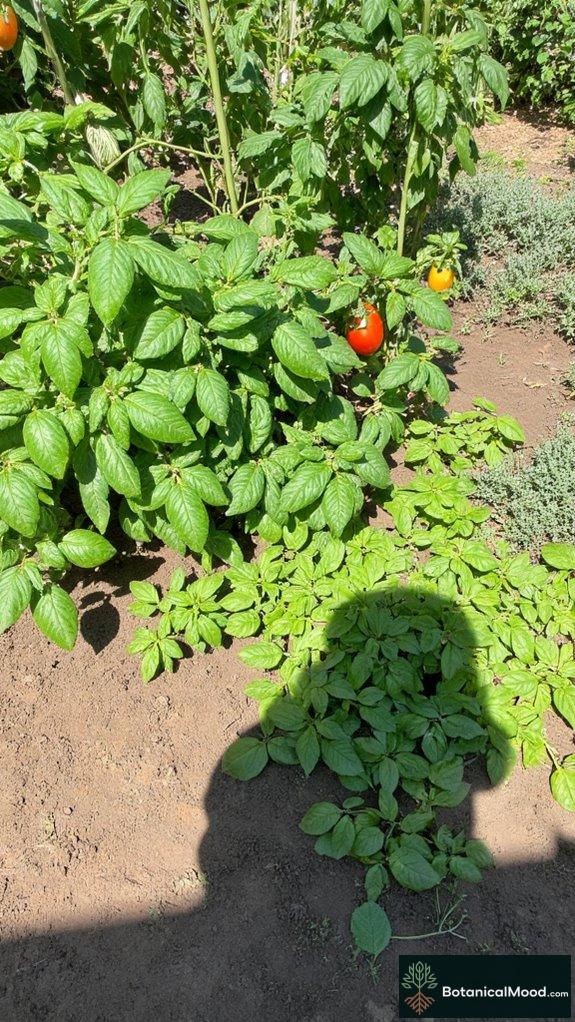
When I plant basil alongside my tomatoes and peppers, I’m not just creating a colorful display; I’m elevating the flavor profile of my garden’s harvest.
Basil’s aromatic oils enhance the sweetness of tomatoes while complementing the heat of peppers beautifully.
Here’s how I achieve that exquisite flavor synergy:
- Tomatoes: The classic pairing, basil heightens their juicy sweetness.
- Peppers: Basil tempers their heat, creating a balanced taste.
- Oregano: Together, they infuse Italian dishes with depth.
- Eggplant: Basil’s fresh notes cut through the richness of eggplant.
With these combinations, every dish resonates with the essence of my garden.
In addition, the companion planting benefits of basil extend beyond flavor, as these plants can help deter pests that threaten your crops.
Alluring Borage: Attraction and Aesthetics

The striking beauty of borage captivates both the eye and the bees, making it a delightful addition to any garden. Its star-shaped, vibrant blue flowers draw in pollinators, while the lush green foliage offers a perfect backdrop, creating an enchanting tapestry of color and life.
As I plant borage alongside my herbs, I can’t help but admire how it brightens my garden space and enhances the overall aesthetic. Known for its robust growth and resilience, it thrives in well-drained soil, enriching my garden’s appeal while fostering a magical atmosphere. Additionally, borage has been shown to attract diverse pollinators essential for a thriving ecosystem.
That’s why I created Botanical Mood—to share such transformative experiences.
Comfrey’s Role in Nutrient Cycling
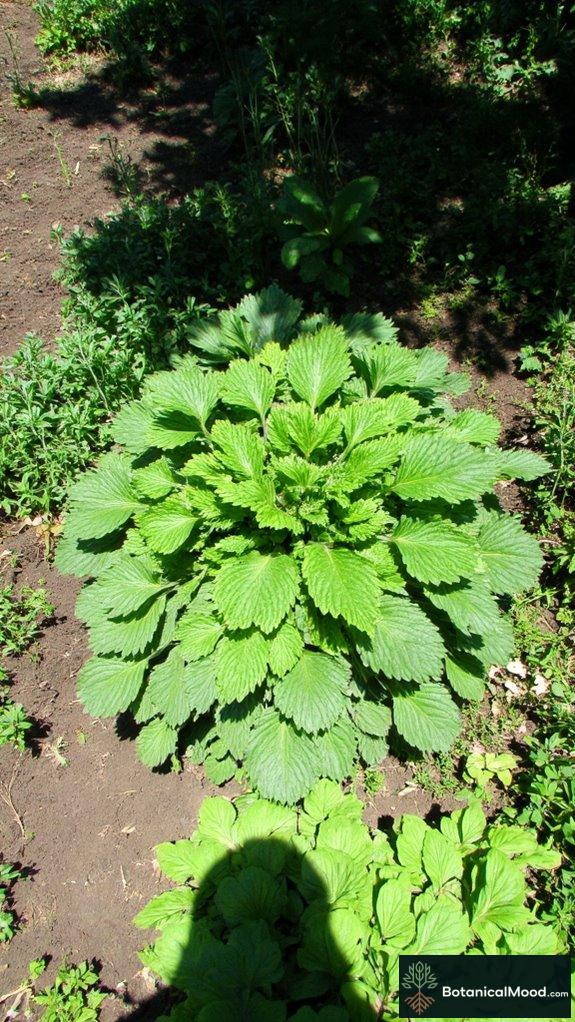
As I explore the world of nutrient cycling, I find that comfrey stands out as a powerhouse in the garden ecosystem. This perennial herb’s deep roots tap into essential nutrients, bringing them closer to the surface for my plants to access.
I love how comfrey contributes to my garden through:
- Enhancing soil structure with its abundant biomass
- Providing crucial nutrients like nitrogen, potassium, and calcium
- Attracting pollinators, enriching my garden’s biodiversity
- Acting as a natural mulch, suppressing weeds and retaining moisture
Purslane’s Soil-Benefiting Properties

Though often overlooked, purslane (Portulaca oleracea) is a vibrant, succulent plant that brings a wealth of benefits to the soil, harnessing its unique properties to enhance the garden ecosystem. As I’ve discovered in my own experience, this resilient plant enriches the ground with nutrients and promotes biodiversity.
| Benefit | Description | Effect on Soil |
|---|---|---|
| Nutrient Accumulator | Builds soil health | Enhances nutrient availability |
| Soil Stabilizer | Prevents erosion | Protects ground structure |
| Moisture Retainer | Reduces water loss | Maintains consistent hydration |
Incorporating purslane truly beautifies both the garden and soil.
The Three Sisters: A Timeless Companion Trio
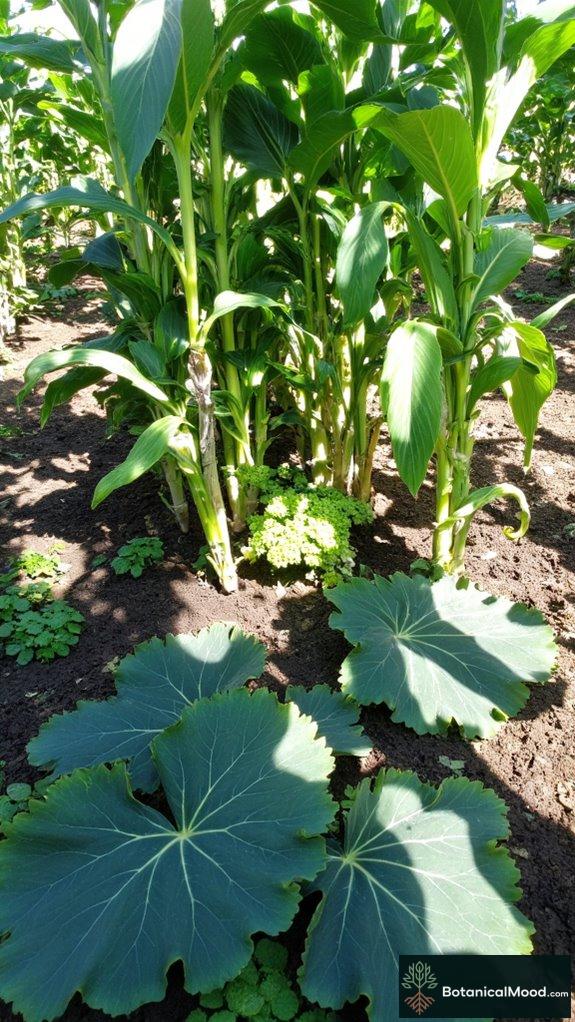
In the domain of companion planting, few combinations rival the synergy achieved with the Three Sisters—corn, beans, and squash. This harmonious trio plays a crucial part in achieving a flourishing garden while nurturing the soil.
- Corn stands tall, offering support for beans.
- Beans, nitrogen-fixers, enrich the soil naturally.
- Squash sprawls beneath, shielded by its broad leaves, limiting weeds.
- Together, they create a microclimate, optimizing growth conditions.
Embracing this eloquent interplay has deepened my connection to nature, showcasing the beauty of balance and promoting a sustainable garden.
It’s truly a timeless tradition that I treasure.
Herb Growth Enhancement Techniques
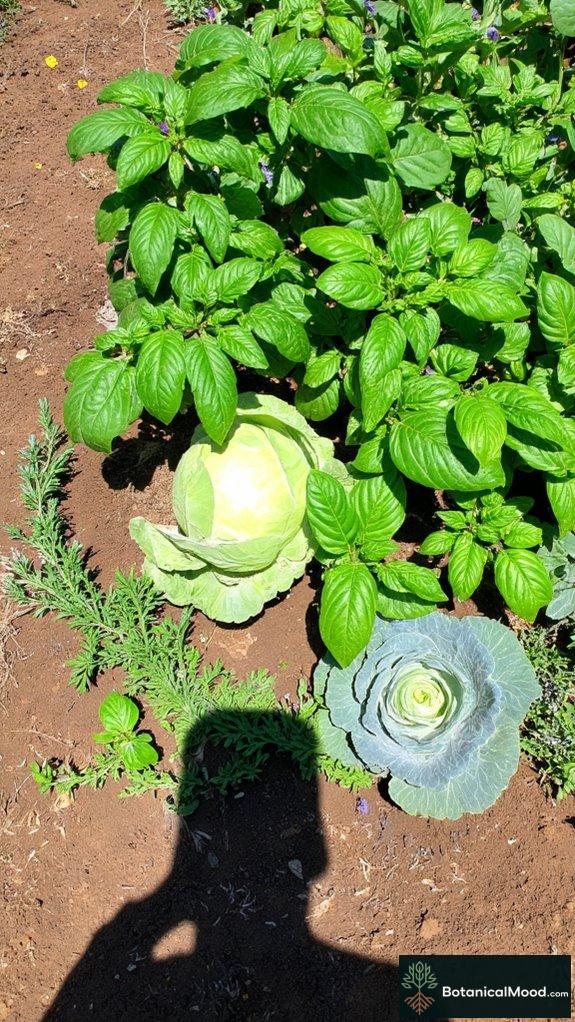
To maximize the growth and health of your herb garden, employing effective enhancement techniques transforms simple plantings into a thriving ecosystem.
By interplanting fragrant herbs like basil with tomatoes, I find my crops repel pests while enhancing their flavor. Companion planting can also provide benefits like pest repellence, further ensuring the vitality of my garden.
Interplanting fragrant herbs like basil with tomatoes repels pests and elevates flavor, fostering a harmonious garden ecosystem.
Planting mint deters aphids, and thyme alongside cabbage curtails infestations, fostering robust growth.
I adore incorporating pollinator-attracting companions like borage and lavender, as they boost not only yields but also biodiversity, creating a harmonious environment.
Each choice in companion planting deepens the connection between herbs and vegetables, turning my garden into a beautiful, productive haven.
Let’s nurture this enchanting growth together!
Permaculture Garden Layout Strategies

When you’re diving into permaculture garden layout strategies, understanding how the diverse elements of your space interact is essential for creating a sustainable and productive ecosystem.
Here are some key strategies to contemplate:
- Choose the right garden bed type, like raised beds or hugelkultur, based on your soil and climate.
- Orient your beds north-south for ideal sun exposure.
- Design pathways that allow easy access while promoting airflow.
- Observe natural patterns in your space, like microclimates, to improve plant placements.
Every choice guides your garden towards resilience, beauty, and a deep connection with nature’s rhythms.
This is why I embrace these principles in my own space.
Meet the Herb Garden Guru

Meet the Herb Garden Guru, Martha Jensen from Seattle, Washington. After years of urban gardening frustrations, Martha sought to create a thriving herb garden that not only beautified her space but also provided fresh culinary ingredients.
Martha initiated her garden design journey by researching the best practices for herb cultivation, focusing on sunlight, soil drainage, and moisture levels. She meticulously mapped out her garden layout, grouping herbs by similar watering needs and considering their growth cycles to maximize their health and productivity.
To bring her vision to life, Martha utilized quality tools such as the Fiskars pruning scissors and a Gardenia moisture meter. She consulted local horticulturists and incorporated features like raised beds from CedarCraft for effective drainage.
Garden accessories like decorative labels guaranteed easy identification of each herb, adding a personal touch to her flourishing garden.
Popular Culinary Garden Favorites
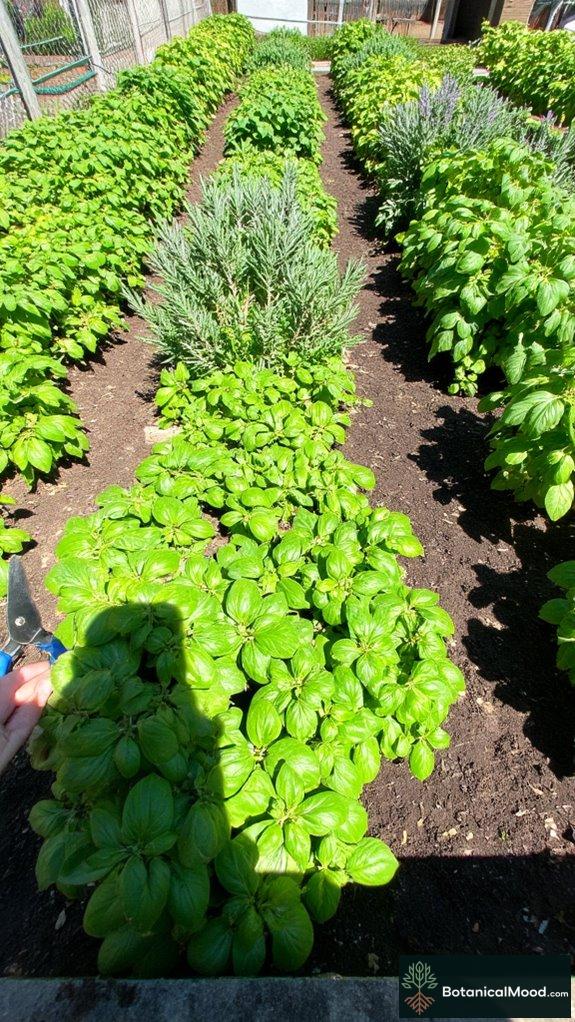
Culinary gardens brim with an array of flavors and colors, and it’s no surprise that some herbs and vegetables have become favorites for home gardeners.
Basil’s aromatic leaves pair beautifully with tomatoes, while rosemary draws in essential pollinators.
Envision the vibrant greens of lettuce mingling with the bright reds of peppers or the brilliant yellow of summer squash weaving through your garden.
Each element, like chives and cilantro, enhances flavors and biodiversity, creating a thriving ecosystem.
I cherish these robust plants, knowing they not only beautify my garden but also elevate my culinary creations, reflecting the essence of my passion for nurturing this beautiful botanical world.
References
- https://www.unsustainablemagazine.com/companion-planting-increases-yield/
- https://www.rainbird.com/homeowners/blog/the-benefits-of-companion-planting
- https://www.epicgardening.com/companion-planting-fad-or-science/
- https://www.thehomesteadgarden.com/the-benefits-of-companion-planting-in-your-garden/
- https://www.gardenmyths.com/companion-planting-truth-myth/
- https://zamzows.com/blogs/lawn-garden/supercharge-your-garden-with-strategic-companion-planting-tips-tricks-and-techniques
- https://www.attainable-sustainable.net/companion-planting/
- https://growingspaces.com/blog/how-to-succeed-with-companion-planting/
- https://www.gardendesign.com/vegetables/companion-planting.html
- https://greenthingsaz.com/the-organic-garden-herbs-as-companion-plants/
- https://permacultureapprentice.com/crisis-garden-layout/
- https://deepgreenpermaculture.com/a-comprehensive-guide-to-david-holmgrens-permaculture-design-principles/
- https://www.permaculturegardens.org/design-your-permaculture-garden
- https://www.smilinggardener.com/organic-vegetable-gardening/permaculture-principles/
- https://extension.oregonstate.edu/sites/extd8/files/2018-07/permaculture_basics_for_home_gardeners1.pdf
- https://ucanr.edu/site/uc-master-gardeners-santa-clara-county/herb-gardening-basics
- https://www.youtube.com/watch?v=9m7T1sVR5pY
- https://www.youtube.com/watch?v=T7NTXfn6WcY
- https://agrilifetoday.tamu.edu/2024/09/18/herb-gardening-tips-for-texas/
- https://www.gardenary.com/blog/the-ultimate-guide-to-growing-herbs
- https://foodgardening.mequoda.com/daily/vegetable-gardening/a-small-kitchen-garden-vegetable-list/
- https://www.gardenary.com/blog/five-of-the-best-vegetables-to-grow-in-the-kitchen-garden
- https://www.finegardening.com/article/what-the-chef-grows
- https://www.seedsnow.com/blogs/news/14694693-the-most-popular-vegetables-grown-in-american-backyards
- https://hgic.clemson.edu/factsheet/vegetable-and-herb-crops-ranked-by-difficulty-for-home-gardeners/
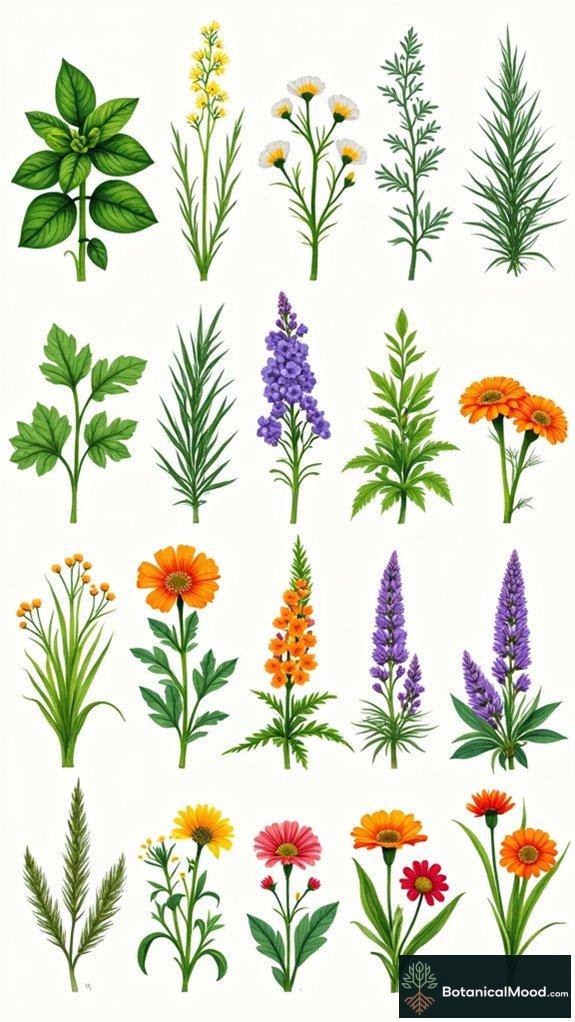
Leave a Reply